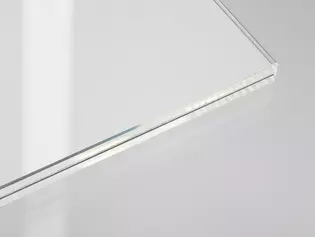Making doors safe(r)
How secure and resistant doors are depends on various factors. Exterior and interior doors: The door material, the door lock case and the hinges have different resistance classes. What are they, and how can doors be retrofitted?
Prevent damage to the door
Over time, doors can wear out and suffer minor damage. However, in most cases, these minor blemishes are easy to remove. Unlike glass doors, wooden doors require regular maintenance. Varnishes and oils for wood, enhance the appearance of wooden doors and protect the material. Small dents can be previously treated with putty and sandpaper before painting or varnishing.

In most cases,glass doors are made of toughened safety glass (TSG). A special heat treatment makes it particularly impact-resistant. If it does break, rounded shards form without sharp edges. Laminated safety glass (LSG) is made of at least two such glass panes. There is a no foil between the washers, which keeps the washer together even in case of breakage.
Depending on the area in the house, it makes sense or none to use glass doors: In the case of front doors, we advise doors with light openings instead of full glazing. In interior areas that are highly frequented and subject to greater stress - for example, from children playing - you should use LSG glass.
Resistance classes of doors
When people talk about the security of doors, they also mean, above all, burglar resistance. How great is the resistance of the respective door when one tries to break it open with different tools? To answer this question, tests are carried out to determine how long it takes for the door to be broken open. Depending on the results, the doors are classified into different categories. Windows and doors are therefore classified by the Europe-wide DIN EN 1627 norm with regard to their burglary resistance. The seperate categories are called: RC 1 N, RC 2 N, RC 2, RC 3, RC 4, RC 5 and RC 6. The lowest protection is offered by RC 1 N protection. The most secure burglary protection is offered by RC 6. For front doors, a high burglary protection should be selected - at least RC 2 or higher. Assess burglary risk: Doors with high burglary protection should also be selected for basement doors or poorly lit side entrances to buildings.
Design doors safely
There are various ways to make a door burglar-resistant. Even nn existing doors can be retrofitted to make them even more secure. In addition to the actual door locks , there are other types of door locking. Different types of (multiple) locks, make it difficult for burglars and increase the security of the doors:
Additional locks
So-called additional box locks are screwed to the inside of the door leaf and can be operated with a key or rotary knob.
Locking bracket
Similar to door chains, locking brackets allow you to open the door only a crack. They are screwed to the inside of the door leaf and frame.
Crossbar locks
Bulletproof deadbolts or crossbolt locks are mounted diagonally on the door behind the door. They protect against the door being pried open and provide high pressure resistance.
Tape fuses
Hinge locks are for protection of hinges against prying.
Bar locks
Bar locks are installed when it is not possible to install side-mounted bars. They are mounted vertically.
General tips for retrofitting doors
Every door can be retrofitted and thus increase the burglar-resistant effect of doors. It is important that the hardware, door leaf, door locks, hinges and door frame are all properly coordinated. Even the most secure cylinder lock will not prevent the door from being levered out. However, the door leaf of a house door should have a thickness of at least 40 mm. If this is not the case, it is better to replace the door with a new one. In any case, it is advisable to have the installation done professionally.

Supplementary safety measures
Beyond mechanical protection, there are some behaviors that should be followed. Lock your side and patio doors and also lock them when you leave the house. For patio doors, close the shutters as well.
Never keep a spare front door key under the doormat. The front door should also be locked rather than simply pulled shut when leaving the house. If you ever lose your front door key, change the cylinder lock. Door intercoms with video surveillance are another possible additional measure.